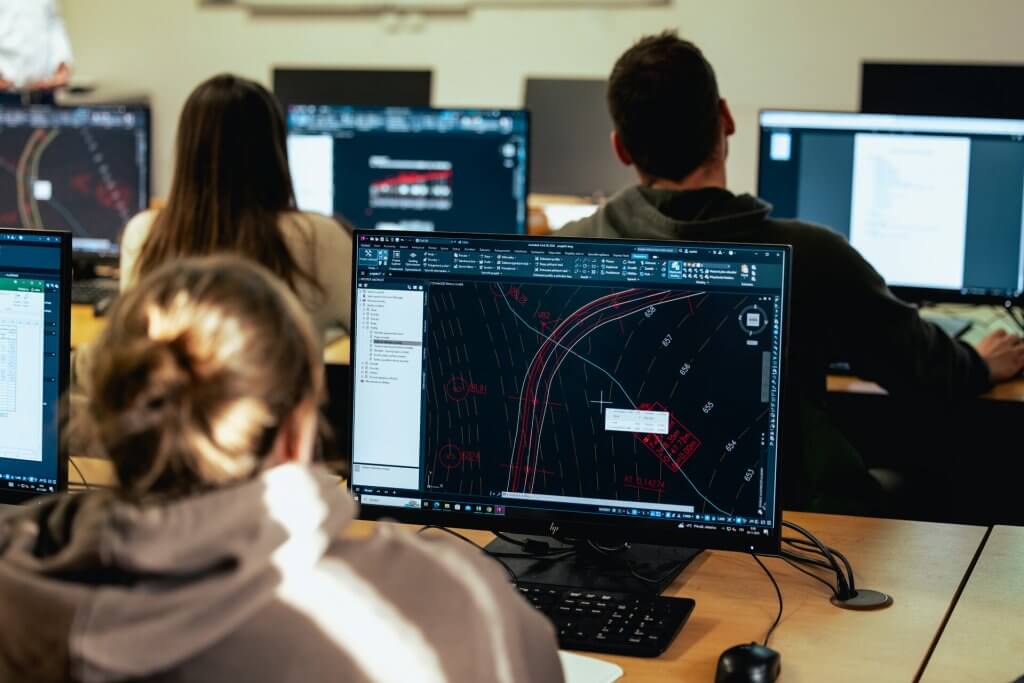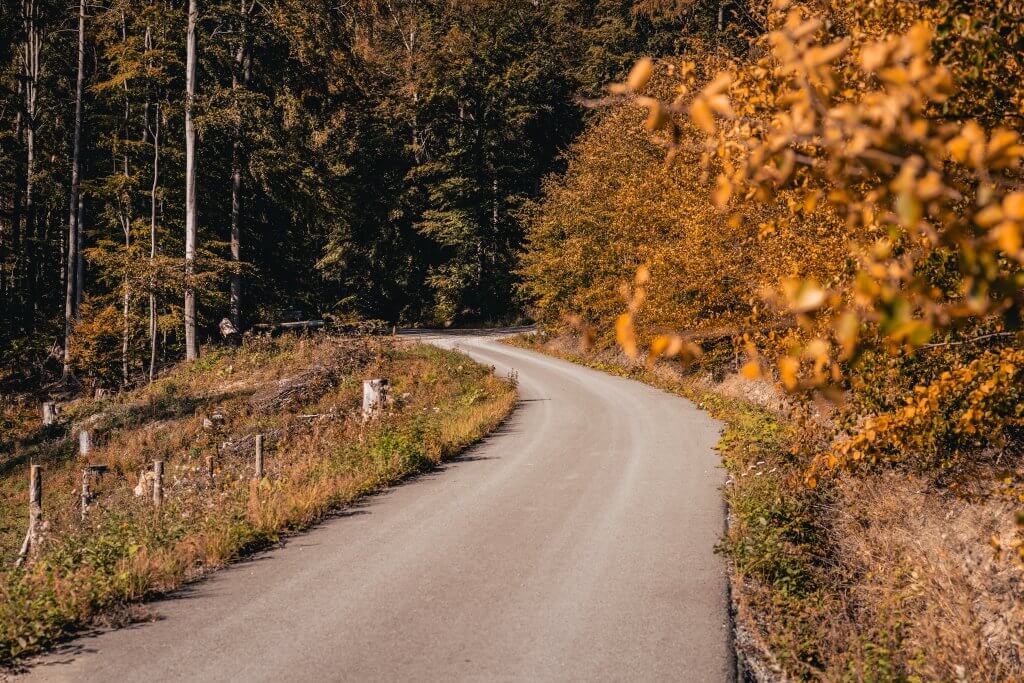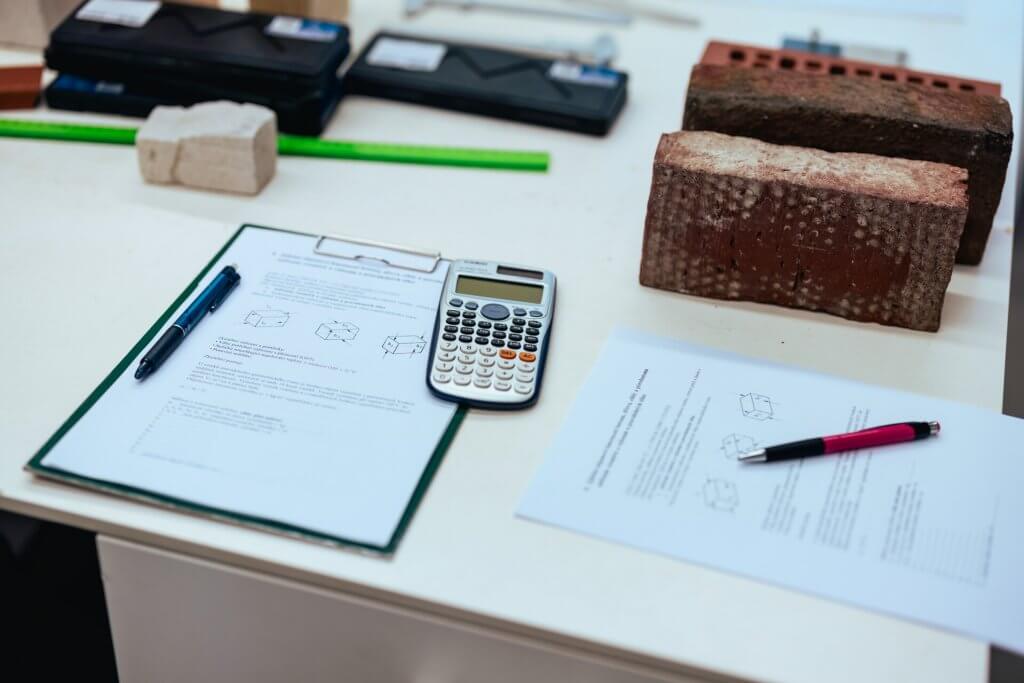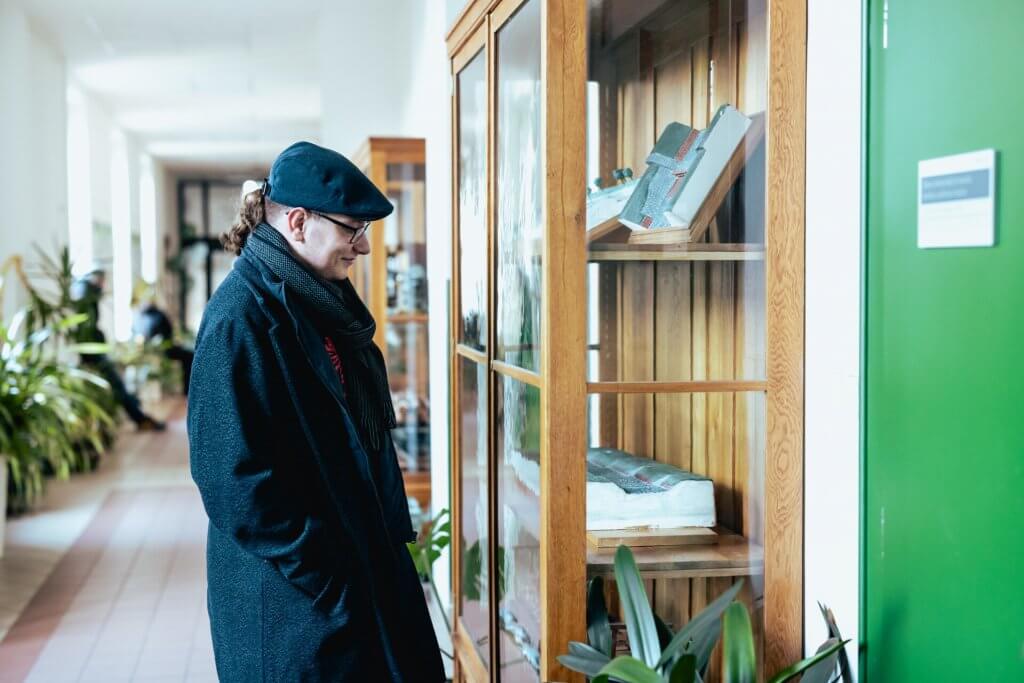Departmental Description – what we do
- General hydrology
- Forest hydrology
- Hydraulics
- Nature-based stream treatment
- Revitalisation of streams
- Damming of rapids and ravines
- Water retention in the landscape
- Making the landscape accessible for recreational purposes
- Forest transport network
- Dirt roads
- Optimising access to the landscape
- Complex biotechnical landscape improvements
- Hydraulic and anti-erosion landscape modifications
- Use of tree species and their functional types
- Landscape reclamation
- Landscape revitalisation
- Accessibility structures – road networks and their accessories
- Small water management structures
- Small water reservoirs and ponds
- Functional building structures in the landscape (recreational, anti-erosion, etc.)
- Soil mechanics, building foundations, technical and structural mechanics
- Buildings intended for forest functions
- Water management and landscape engineering
- Territorial systems of ecological stability
- Biotechnical landscaping
- Land improvements
- Functional types of woody vegetation in the landscape
- Optimising use of productive landscape functions
- Quantification of landscape hydric functions
- Landscape stabilisation functions
- Recreational landscape functions – quantification, optimisation and interpretation
Background – where we work
- Building B on the university campus – houses the main facilities for scientific work and teaching. The Department’s offices are located on the 4th floor, while the classrooms can be found on the 4th and 6th floors.
- The Soil Mechanics Laboratory, located on the 4th floor, provides facilities for testing required to classify soils for construction purposes, from index tests required for the design of landscaping structures to mechanical property (deformation and strength) tests required for the design of linear and civil structures.
- The Masaryk Forest Living Lab (School Forest Enterprise Křtiny; near the town of Křtiny) aims to become part of a European network of Living Labs established under the European Union’s Horizon Project ‘Water4All’. The laboratory focusses on all aspects of forest water retention, with a main mission to provide accurate data on rainfall-runoff processes and the hydrological balance of forests and to test potential elements that serve to retain water in forests.









Cooperation – we are not alone
- As the Department is application and design oriented, cooperation with commercial and external institutions has become an integral part of its activities. Experts from commercial and cooperating institutions regularly take part in practical classes and excursions, are members of various teaching advisory bodies and participate in projects. International cooperation takes place primarily through scientific research collaboration, with members of the Department publishing, submitting projects and participating in conferences with foreign colleagues.
Professional and assessment activities
- The Department’s staff have range of expertise in forestry, water management and the environment (forensic expertise) and are regularly called upon to carry out professional assessment activities in the fields of water management, landscape engineering, suburban forestry, spatial planning and development, recreology and construction materials engineering.
- Paměť krajiny, s.r.o. – biotechnika krajinné zeleně
- Povodí Moravy a.s. – vodní hospodářství
- Šindlar, s.r.o. – krajinné inženýrství
- Ekostavby, s.r.o. – drobné stavby v krajině
- ŠLP Křtiny – lesní hospodářství
- Správa CHKO Moravský Kras – ochrana přírody
- Ateliér Fontes, s.r.o. – krajinné inženýrství
- Aquasys, s.r.o. – krajinné inženýrství
- GEOSTAR, spol. s r. o. – materiálové inženýrství
- Sdružení pro interpretaci místního dědictví – funkce krajiny
- FAST VUT v Brně
- Výzkumný ústav vodohospodářský TGM Praha, v.v.i
- Univerzita Jana Evangelisty Purkyně Ústí nad Labem
- Báňská univerzita Ostrava, pobočka Brno
- VÚKOZ, v.v.i.
- Centrum dopravního výzkumu, v. v. i.
- Poradní sbor ŠLP Křtiny
- Společnost pro krajinnou ekologii – IALE
- Expertní komise Ekologie při mezinárodní komisi pro ochranu Dunaje – MKOD
- Interní grantová agentura LDF MENDELU
- Poradní sbor Naše společná krajina
- Česká společnost krajinných inženýrů
- Česká bioklimatická společnost
- Expertní skupiny při GAČR, TAČR
- Expertní skupiny při KEGA, VEGA
- MRS, ČMMJ
- Interpret Europe
- Sdružení pro interpretaci místního dědictví
- Slovenská poľnohospodárska univerzita v Nitre, Slovakia
- Technická univerzita v Košiciach, Slovakia
- Technická univerzita vo Zvolene, Slovakia
- Warsaw University of Life Sciences, Poland
- Akademia Górniczo-Hutnicza im. Stanisława Staszica w Krakowie, Poland
- University of Basilicata, Italy
- Kauno miškų ir aplinkos inžinerijos kolegia, Lithuania
- University of Bucharest, Romania
- Zagazig University, Egypt
- Univerzitet u Beogradu, Serbia
- Sveriges lantbruksuniversitet Uppsala, Sweden
- Guimaras State University, Philippines
- Visayas State University, Philippines
- Royal University of Agriculture, Cambodia
- Università degli Studi di Padova
Departmental Employees – who we are
In addition to meeting the university’s academic requirements, with both academically oriented and chamber-authorised design oriented staff, the Department’s team is structured to include representatives of all specialisations provided by the Department. Great emphasis is placed on supporting young staff members, especially junior researchers and PhD students.
Head of department – Department of Landscape Management
Vice-dean – Faculty of Forestry and Wood Technology
Department of Landscape Management
Staff
-
Ing. Martina Brychtová
Výzkumník projektu III
Office: B4.23
E-mail: martina.brychtova@mendelu.cz
-
Ing. Petr Čech
Výzkumník projektu I
Office: B4.26
Phone: +420 605 967 302, +420 545 134 524
E-mail: petr.cech.utok@mendelu.cz
-
Ing. Jan Deutscher, Ph.D.
Assistant Professor
Office: B4.06
Phone: +420 545 134 087
E-mail: jan.deutscher@mendelu.cz
-
Sylva Dvořáková
Technical worker for educational process
Office: B4.05
Phone: +420 545 134 083
E-mail: sylva.dvorakova@mendelu.cz
-
doc. Bc. Ing. Jitka Fialová, MSc, Ph.D.
Academic staff – Associate Professor
Office: B4.09
Phone: +420 545 134 096
E-mail: jitka.fialova@mendelu.cz
-
doc. Ing. Petr Hrůza, Ph.D.
Academic staff – Associate Professor
Office: B4.08
Phone: +420 545 134 085
E-mail: petr.hruza@mendelu.cz
-
Ing. Pavla Kotásková, Ph.D.
Assistant Professor
Office: B4.14
Phone: +420 545 134 010
E-mail: pavla.kotaskova@mendelu.cz
-
doc. Ing. Petr Kupec, Ph.D.
Academic staff – Associate Professor
Office: B4.12
Phone: +420 545 134 097
E-mail: petr.kupec@mendelu.cz
-
Ing. Jana Marková, Ph.D.
Assistant Professor
Office: B4.11
Phone: +420 545 134 009
E-mail: jana.markova@mendelu.cz
-
Ing. Petr Pelikán, Ph.D.
Assistant Professor
Office: B4.11
Phone: +420 545 134 009
E-mail: petr.pelikan@mendelu.cz
-
Ing. Kateřina Sedláčková
Výzkumník projektu II
Office: B4.23
E-mail: katerina.sedlackova@mendelu.cz
-
Ing. Lenka Ševelová, Ph.D.
Assistant Professor
Office: B4.10
Phone: +420 545 134 093
E-mail: lenka.sevelova@mendelu.cz
-
prof. Dr. Ing. Miloslav Šlezingr
Academic staff – Associate Professor
Office: B4.02
Phone: +420 545 134 520
E-mail: miloslav.slezingr@mendelu.cz
History
- The Department of Landscape Management is one of the founding departments of the Faculty of Forestry and Wood Technology at Mendel University in Brno. Historically, it has been focusing on forest engineering, forest transportation networks, forest reclamation and torrent control. In recent times, it has expanded beyond forested areas, emphasizing multifunctional use of landscape biotechnics.
- The department was founded in 1920 as one of four core departments of the newly formed Department of Forestry at the University of Agriculture in Brno. One of the founding members was Professor Ferdinand Müller, an expert in forest engineering and torrent control. Initially, the department focused on teaching road construction, forest engineering, and torrent control.
- From the very beginning, the department focused not only on scientific and educational activities but also on project-based work. Practically immediately after the incorporation of the University Forest Estate into the organizational structure of the University of Agriculture in 1923, the department began designing forest transport networks and forestry structures, as well as addressing stream regulation and identifying suitable sites for small water reservoirs.
- Prof. Dr. Ing. Leo Skatula, a graduate of the Vienna Hochschule für Bodenkultur and a proponent of the Alpine school of torrent control, built upon the concept of the Department of Forest Structures, which was successfully led by Professor Müller until 1945. Professor Skatula headed the department until 1961. During this time, the department had three key sections: Forest Transportation and Torrent Control, Forest and Agricultural Civil Engineering, and Soil, Water, and Climate Protection.
- In 1950, the department was renamed the Department of Forest Structures and Land Reclamation, and these sections became independent departments. Prof. Skatula introduced the concept of combining biological and technical (biotechnical) measures, which remains a guiding principle for all forest-engineering practices in small catchment areas. The aforementioned comprehensive concept of biotechnical measures in forest engineering, forest land reclamation, and torrent control remains valid to this day.
- In 1961, Prof. Ing. Otakar Riedl became the head of the department, and partly due to his expertise, the department was renamed the Department of Forest Structures, Land Reclamation, and Torrent Control. The main focus of the department’s activities during this period was primarily on addressing tasks in applied forest hydrology, forest land reclamation, and torrent control.
- In 1971, Prof. Ing. Jiří Beneš took over the leadership of the department and headed it until 1986, when the department was dissolved. Its staff members were then reassigned based on their expertise to the Department of Forest Mechanization and Repair and the Department of Forest Protection. Given Prof. Beneš’s expertise, the focus of the department during the period of 1971–1986 shifted more towards the area of forest accessibility, specifically the optimization of the forest road network within the context of the forest management units of that time.
- The Department of Forest Constructions and Land Reclamation was re-established on February 1, 1990, and Prof. Ing. Jiří Krešl became its head. Prof. Krešl led the department only until 1991, when he was elected the Dean of the Faculty of Forestry and Wood Technology. In April 1991, the Department of Forest Constructions and Land Reclamation was transferred to the Department of Forest Constructions and Land Reclamation (an organizational change within the then University of Agriculture).
- In 1991, Prof. Ing. Jaroslav Herynek, despite his expertise in forest reclamation, took over as head of the department and re-established a balance between the department’s main fields.
- In 1998, Prof. Ing. Václav Tlapák, a student of Prof. Skatula, who successfully led the department until 2004, became the head of the department. Prof. Tlapák was instrumental in establishing the Landscape Engineering programme at the FFWT, mainly as a response to the declining interest in “traditional” forest construction at that time. During this period, the dominant theme of the department was the complex solution of landscape biotechnics, i.e., the application of principles formulated by Prof. Skatula in the requirements of current forest and landscape engineering practice.
- From 2004 to 2008, Prof. Ing. Ilja Vyskot headed the department. Due to his expertise, he initiated the change of the department’s name to the Department of Landscape Conservation and Management. With the change of the department’s name, Prof. Vyskot shifted the department’s focus towards the integrated utilization of landscape space and away from the department’s original specializations.
- With the appointment of Prof. Dr. Ing. Miloslav Šlezinger as head of the department in 2008, the balance of the department’s specializations was restored, and in 2012, the department was renamed to its current name: The Department of Landscape Management.
- In 2013, Assoc. Prof. Ing. Petr Kupec, Ph.D., assumed the position of head of the department. His professional focus aligns with the concept of multifunctional use of landscape biotechnics, building on the department’s traditional expertise in engineering structures, forest reclamation, and torrent control. Under his leadership, the department has expanded its focus beyond classical forestry and landscape applications of landscape biotechnics to include its use in cultural and social contexts. The department currently places strong emphasis on scientific research, internationalization, and cooperation with partner institutions not only in Europe but also in Southeast Asia.